Abstract
Objective
Lumbar spinal stenosis is a common degenerative spine disease that requires surgical intervention. Currently, there is interest in minimally invasive surgery and various technical modifications of decompressive lumbar laminectomy without fusion. The purpose of this study was to present the author's surgical technique and results for decompression of spinal stenosis.
Methods
The author performed surgery in 57 patients with lumbar spinal stenosis between 2006 and 2010. Data were gathered retrospectively via outpatient interviews and telephone questionnaires. The operation used in this study was named central decompressive laminoplasty (CDL), which allows thorough decompression of the lumbar spinal canal and proximal two foraminal nerve roots by undercutting the lamina and facet joint. Kyphotic prone positioning on elevated curvature of the frame or occasional use of an interlaminar spreader enables sufficient interlaminar working space. Pain was measured with a visual analogue scale (VAS). Surgical outcome was analyzed with the Oswestry Disability Index (ODI). Data were analyzed preoperatively and six months postoperatively.
Results
The interlaminar window provided by this technique allowed for unhindered access to the central canal, lateral recess, and upper/lower foraminal zone, with near-total sparing of the facet joint. The VAS scores and ODI were significantly improved at six-month follow-up compared to preoperative levels (p<0.001, respectively). Excellent pain relief (>75% of initial VAS score) of back/buttock and leg was observed in 75.0% and 76.2% of patients, respectively.
Lumbar spinal stenosis (LSS) is a common cause of low back pain and lower extremity pain in older adults. The characteristic clinical manifestations of LSS include periodic exacerbations of low back and leg pain and neurogenic claudication, with resulting compromise in health-related quality of life, mobility, and independence24).
The optimal treatment strategy for LSS has not yet been defined. Non-operative treatments including restriction of activity, posture modification, and epidural steroid injections are useful for LSS symptoms of mild-to-moderate severity. Decompressive surgery is indicated for severe degree stenosis with neurogenic claudication, neural structure compromise, and/or intractable radicular symptoms.
Although conventional laminectomy is the standard option of neural structure decompression, it can cause instability12) and result in a less favorable outcomes at long-term follow-up21). Various technical modifications of the standard laminectomy have been reported in an attempt to adequately treat patients with spinal stenosis while maximizing the structural preservation of the spine4,6,8,11,16,19,22).
The purpose of this study was to present the author's surgical approach for decompression of LSS and to report early surgical results. This technique, which the author named central decompressive laminoplasty (CDL), involves undercutting the facet and upper lamina with maximal neural structure decompression and minimal resection of bony structures related to stability.
The surgery was performed in 57 patients with LSS between 2006 and 2010. Clinical data were gathered retrospectively via electronic chart review. The surgical indication included LSS due to hypertrophy of the facet joint and ligamentum flavum. Spinal stenosis accompanied by a herniated disc was also included. All patients underwent relevant neurological and radiological examinations and pain was measured separately for the low back/buttock and the legs according to self-assessment on a 10-point visual analogue scale (VAS). Functional disability was assessed using the Oswestry Disability Index (ODI), which has been validated for Korean-language speakers10).
Preoperative lateral lumbar radiographs with flexion and extension views were taken of all patients to identify spondylolisthesis. The degree and level of stenosis were verified using magnetic resonance imaging (MRI) and/or computerized tomography (CT) with three-dimensional reconstruction. In cases with multiple lesions, symptomatic sites were determined by thorough neurological examination and incentive review of radiological findings to minimize surgical sites.
Perioperative clinical survey and X-rays were checked regularly. Follow-up was limited to six months, and the analysis of results was restricted to this early surgical period. Data were analyzed using the PASW Statistics 18.0 (IBM, Armonk, NY, USA). The paired samples t-test was used to test the difference between preoperative and 6-month postoperative values of VAS and ODI.
Under general anesthesia, patients were positioned on the Wilson frame, and correct position of the incision was verified using C-arm fluoroscopy. After a 3-cm midline skin incision, a small retractor was applied over the lumbar fascia. Sharp incision with a No. 10 blade was performed over the spinous process and down to the interspinous area. The sharp division and careful dissection of the ligaments from the spinous process enabled the functional closure of the supraspinous and interspinous ligaments when closing the fascia after the operation. Then bilateral dissection of the muscles was performed to expose the vertebral laminae at the stenotic level. Special care was taken when dissecting over the facet joint, so that the capsules were not violated. After retraction of dissected muscle bilaterally using a Caspar retractor, the inferior 1/4 to 1/3 of the spinous process of the cranial vertebra and the superior portion of the lamina in the caudal vertebra were removed with a bone rongeur. The spinolaminar junction of the cranial and caudal vertebrae then was drilled away with a cutting burr. The kyphotic prone positioning on elevated curvature of the frame or occasional use of interlaminar spreader enabled sufficient interlaminar working space for decompression by mobilizing the cranial lamina proximally and the caudal lamina distally (Fig. 1). Distraction was achieved by motion through the facet joints and disc.
A dissector was then used to mobilize the ligamentum flavum insertion from the inner surface of the cranial lamina. Soft tissue, including the ligament, was removed with a rongeur. The capsular portion of the ligamentum flavum was not disturbed to maintain facet joint stability. Dissected ligamentum flavum below the cranial lamina could be completely removed. Using a high-speed drill and spinal punches, undercutting of the inner surface of the cranial lamina was performed. Removal of the internal portion of the lamina extended to the proximal site of the ligamentum flavum insertion.
Decompression of nerve roots was performed with an operating microscope, starting from the side contralateral to the operator. The contra-lateral approach allows undercutting of the facet joint while decompressing the distal traversing root. Moreover, tilting the operative table down toward the opposite side provided the surgical view for decompression of proximal exiting root via undercutting of the upper lamina and removal of the tip of the hypertrophic superior articular process (Fig. 2). The medial facet was removed 10% to 20% in a tapered fashion, which allowed complete sparing of the capsule overlying the joint. Special care was taken when decompressing the traversing root. Complete decompression was performed along the pedicle to the lowermost part of the recess, at the turning point of the root into the foramen. Good exposure of the disc space was possible, and discectomy was performed when a soft herniated disc was identified. The divided supraspinous and interspinous ligaments were closed tightly after insertion of a drain onto the lamina. After subcutaneous tissue was stitched, the skin was taped with adhesive strips.
Operations were performed in 57 patients including 16 men and 41 women. Average age was 64.4 years (range, 46-87 years). All patients had limited functional ability due to back/buttock or leg symptoms despite prolonged conservative treatments including medication, physical therapy, and injection therapy. The symptoms were low back/buttock pain (81%), leg pain (68%), and neurologic claudication (53%). Symptom duration before surgery ranged from two months to 10 years. The L3-4 and L4-5 levels were most commonly involved in 22 (39%) and 45 (79%) cases, respectively. Thirty-seven patients underwent CDL for single level stenosis, 18 for two levels, and 2 for three levels. In 5 patients, discectomy was simultaneously performed at the same level as CDL. All patients responded well to the surgery and none required a revision procedure due to sustained or aggravated symptoms. No significant complications occurred except for a dural tear in six patients. After primary repair of the torn dura during the operation, all patients tolerated the procedure well.
The VAS scores and ODI were improved at six-month follow-up compared to preoperative levels. The mean VAS scores of back/buttock pain decreased significantly after operation (from 5.1±2.0 to 1.3±2.6, p<0.001). The mean VAS scores of leg pain also decreased significantly after operation (from 5.5±2.1 to 1.5±2.2, p<0.001). The mean ODI decreased significantly after operation (from 42.8±18.1 to 19.0±21.6, p<0.001). An excellent outcome, defined as over 75% improvement of initial VAS score of back/buttock pain and leg pain was observed in 75.0% and 76.2% of patients, respectively.
During the six-month follow-up, none of the patients showed significant symptomatic recurrence requiring revision surgery. One patient was treated by caudal epidural block due to leg pain. No patients developed aggravated instability on final plain radiography.
Decompressive laminectomy is a common technique for treatment of degenerative LSS. Despite wide variation across studies and little data from long-term follow-up, the outcome of the procedure has generally been reported as deteriorating over time13,14,18). Sufficient dural and root decompression accompanied by minimal resection of the facet joint provided good results in other series6,17). These results suggested that wide decompression with preservation of biomechanical stability, especially in the facet joint area, is required for long-term success of the decompressive procedure.
Unfortunately, under conventional total laminectomy, wide neural canal decompression may remove the pars interarticularis and necessitate significant resection of facet joints that provide spinal stability. Resection of excessive facet joints may also contribute to elevation of intradiscal pressure by establishing an alternate path of axial loading, transferring forces to the disc and longitudinal ligament7). Subsequently, disc degeneration may be accelerated, and further aggravation of disc disease or degenerative spondylolisthesis may occur.
Various technical modifications of lumbar laminectomy have been suggested to minimize the limitations of the procedure. These include bilateral laminotomy4,8) and unilateral laminotomy with bilateral decompression11,16,19). These modifications are intended to safeguard spinal stability by preserving the midline supporting structures, such as spinous processes and interspinous ligaments, while decompressing the central and lateral areas of the surgical level. Adequate decompression and its relation to a good surgical outcome have been reported5,9,20). These approaches do have some technical and theoretical limitations. The surgical corridor for access to the ipsilateral lateral recess and foraminal area is hindered, because the midline structures are not removed during decompression. Therefore, facet capsule violation and greater facet joint resection are needed to decompress the ipsilateral side of the lateral recess and neural foramen. As a result, these approaches may compromise stability and be harmful over the long-term. Additionally, access to the central area is restricted, making decompression difficult. During unilateral laminotomy with bilateral decompression, a narrow corridor to the opposite side of the lateral recess and foramen makes sufficient decompression difficult and requires significant thecal sac compression, which increases the possibility of neural injury and dural tear. To achieve sufficient decompression for the neural structures, this technique necessitates removal of critical bony structures, such as facet joints and capsules, while preserving structures less important to spinal stability (spinous processes and interspinous ligaments).
To overcome this limitation, a series of authors have performed specific modifications, which provide wide decompression while preserving facet stability by minimal bony resection. Two representative techniques were published as modifications of laminectomy. In 1981, Getty et al.6) performed a prototype of partial undercutting facetectomy for LSS to provide stability during nerve root decompression. A long-term, retrospective study of 57 patients who underwent the facet-sparing surgery was performed17). During a minimum five-year follow-up, 88% of patients maintained symptomatic improvement, and 72% had an excellent outcome with no leg pain at all at the final visit. In contrast, a prospective five-year follow-up study with conventional total laminectomy reported that the outcome was less favorable, showing 52% excellent outcome at final13). For a wider view during decompression, facet-undercutting methods have been modified with the additional lumbar spinous process splitting technique15,22,23). This technique provides sufficient working space for decompressive laminectomy by retracting the split spinous process. Because the paraspinal muscle is not detached from the spinous process, the muscle damage can be minimized. A randomized controlled study demonstrated that the splitting technique lessened postoperative back pain and prevented muscle atrophy compared with conventional laminectomy23).
In the present study, a modified laminectomy with facet joint preservation and wider decompression of neural structures was used to treat lumbar canal stenosis. The author named the procedure, "central decompressive laminoplasty" because decompression occurs in the central interspinous area and because the posterior arch of the lamina is spared while decompressing the internal hypertrophied area of the lamina and facet joint.
CDL offers two major technical strengths. One is near-total facet joint preservation including the capsule overlying the joint. The other is excellent surgical view and unhindered access to the central canal, lateral recess, and upper/lower foraminal area, providing thorough decompression of the neural element.
The facet joint and its capsule are key structures for spinal stability. Major structures that resist shear forces are the facet joints (33%) and discs (67%)2). While loaded in full flexion, simulated by combined bending and compression, approximately 70% of the bending moment is resisted by facet joint capsules and only 30% by discs3). Spine range of motion was not affected by the division of the supraspinous and interspinous ligaments1). During decompression with CDL, the lesion is approached from the contralateral side. Thus, inclined undercutting of hypertrophic inferior and superior articular processes without any major disruption of facet joints and overlying capsules is possible (Fig. 3). Mobilizing the ligamentum flavum from the inner surface of the cranial lamina and intermittent use of a laminar spreader provide a wide interlaminar surgical window in the prone position on elevated frame. Domed undercutting of the internal portion of the hypertrophied lamina, which compresses central canal or proximal exiting roots is possible using a table or microscope tilting in the coronal and axial plane (Fig. 4, 5). This internal laminoplasty technique can preserve the posterior arch of the lamina and spinous process overlying the spinal thecal sac during decompression of neural tissue, and may prevent epidural fibrosis and help physiologic healing in detached muscle and ligaments as seen in laminoplasty of the cervical spine. In addition, sharp dividing with blade and retraction of the supraspinous and interspinous ligaments with paraspinal muscle bulk could minimize damage to the muscles. Tight closing of the ligaments onto the spinous processes can restore the integrity of the ligaments and may provide additional stability. Using this technique, an excellent outcome showing improvement in back/buttock pain and leg pain (>75% of their initial VAS score) was observed in 75.0% and 76.2% of cases, respectively. These results are comparable to early surgical results showing an excellent outcome using other modified laminectomy technique (ranging from 61% to 79%)15,17).
This is the first study to explain CDL procedure and early surgical results. A long-term follow-up study is underway investigating surgical outcomes of LSS using this procedure. Future research is being planned to do a randomized controlled study comparing this procedure and spinal fusion for treatment of LSS.
This technique makes possible the inclined undercutting of hypertrophied lamina and superior articular processes in the lateral recess area without violating overlying inferior articular processes and joint capsules to maintain facet stability. This means that CDL provides an ideal technique to combine maximal central and lateral decompression with minimal resection of critical bony structures. The wide decompression of neural components while maintaining stability may guarantee good long-term results.
References
1. Abumi K, Panjabi MM, Kramer KM, Duranceau J, Oxland T, Crisco JJ. Biomechanical evaluation of lumbar spinal stability after graded facetectomies. Spine (Phila Pa 1976). 1990; 15:1142–1147. PMID: 2267608.

2. Adams MA, Hutton WC. The mechanical function of the lumbar apophyseal joints. Spine (Phila Pa 1976). 1983; 8:327–330. PMID: 6623200.

3. Adams MA, Hutton WC, Stott JR. The resistance to flexion of the lumbar intervertebral joint. Spine. 1980; 5:245–253. PMID: 7394664.

4. Aryanpur J, Ducker T. Multilevel lumbar laminotomies : an alternative to laminectomy in the treatment of lumbar stenosis. Neurosurgery. 1990; 26:429–432. discussion 433. PMID: 2138716.
5. Cavuşoğlu H, Kaya RA, Türkmenoglu ON, Tuncer C, Colak I, Aydin Y. Midterm outcome after unilateral approach for bilateral decompression of lumbar spinal stenosis : 5-year prospective study. Eur Spine J. 2007; 16:2133–2142. PMID: 17712577.

6. Getty CJ, Johnson JR, Kirwan EO, Sullivan MF. Partial undercutting facetectomy for bony entrapment of the lumbar nerve root. J Bone Joint Surg Br. 1981; 63-B:330–335. PMID: 7263743.

7. Haher TR, O'Brien M, Dryer JW, Nucci R, Zipnick R, Leone DJ. The role of the lumbar facet joints in spinal stability. Identification of alternative paths of loading. Spine (Phila Pa 1976). 1994; 19:2667–2670. discussion 2671. PMID: 7899961.
8. Herron LD, Pheasant HC. Bilateral laminotomy and discectomy for segmental lumbar disc disease. Decompression with stability. Spine (Phila Pa 1976). 1983; 8:86–97. PMID: 6867860.
9. Jang JW, Park JH, Hyun SJ, Rhim SC. Clinical outcomes and radiologic changes following microsurgical bilateral decompression via a unilateral approach in patients with lumbar canal stenosis and grade I degenerative spondylolisthesis with a minimum 3-year follow-up. J Spinal Disord Tech. 2012; [Epub ahead of print].
10. Jeon CH, Kim DJ, Kim DJ, Lee HM, Park HJ. Cross-cultural adaptation of the Korean Version Of the Oswestry Disability Index (ODI). J Korean Soc Spine Surg. 2005; 12:146–152.

11. Ji YC, Kim YB, Hwang SN, Park SW, Kwon JT, Min BK. Efficacy of unilateral laminectomy for bilateral decompression in elderly lumbar spinal stenosis. J Korean Neurosurg Soc. 2005; 37:410–415.
12. Johnsson KE, Redlund-Johnell I, Udén A, Willner S. Preoperative and postoperative instability in lumbar spinal stenosis. Spine (Phila Pa 1976). 1989; 14:591–593. PMID: 2749373.

13. Jönsson B, Annertz M, Sjöberg C, Strömqvist B. A prospective and consecutive study of surgically treated lumbar spinal stenosis. Part II : Five-year follow-up by an independent observer. Spine (Phila Pa 1976). 1997; 22:2938–2944. PMID: 9431630.

14. Katz JN, Lipson SJ, Larson MG, McInnes JM, Fossel AH, Liang MH. The outcome of decompressive laminectomy for degenerative lumbar stenosis. J Bone Joint Surg Am. 1991; 73:809–816. PMID: 2071616.

15. Lin SM, Tseng SH, Yang JC, Tu CC. Chimney sublaminar decompression for degenerative lumbar spinal stenosis. J Neurosurg Spine. 2006; 4:359–364. PMID: 16703902.

16. Poletti CE. Central lumbar stenosis caused by ligamentum flavum : unilateral laminotomy for bilateral ligamentectomy : preliminary report of two cases. Neurosurgery. 1995; 37:343–347. PMID: 7477792.
17. Sanderson PL, Getty CJ. Long-term results of partial undercutting facetectomy for lumbar lateral recess stenosis. Spine (Phila Pa 1976). 1996; 21:1352–1356. PMID: 8725928.

18. Scholz M, Firsching R, Lanksch WR. Long-term follow up in lumbar spinal stenosis. Spinal Cord. 1998; 36:200–204. PMID: 9554022.
19. Spetzger U, Bertalanffy H, Naujokat C, von Keyserlingk DG, Gilsbach JM. Unilateral laminotomy for bilateral decompression of lumbar spinal stenosis. Part I : Anatomical and surgical considerations. Acta Neurochir (Wien). 1997; 139:392–396. PMID: 9204106.

20. Thomas NW, Rea GL, Pikul BK, Mervis LJ, Irsik R, McGregor JM. Quantitative outcome and radiographic comparisons between laminectomy and laminotomy in the treatment of acquired lumbar stenosis. Neurosurgery. 1997; 41:567–574. discussion 574-575. PMID: 9310973.

21. Tuite GF, Stern JD, Doran SE, Papadopoulos SM, McGillicuddy JE, Oyedijo DI, et al. Outcome after laminectomy for lumbar spinal stenosis. Part I : Clinical correlations. J Neurosurg. 1994; 81:699–706. PMID: 7755690.
22. Watanabe K, Hosoya T, Shiraishi T, Matsumoto M, Chiba K, Toyama Y. Lumbar spinous process-splitting laminectomy for lumbar canal stenosis. Technical note. J Neurosurg Spine. 2005; 3:405–408. PMID: 16302638.
23. Watanabe K, Matsumoto M, Ikegami T, Nishiwaki Y, Tsuji T, Ishii K, et al. Reduced postoperative wound pain after lumbar spinous process-splitting laminectomy for lumbar canal stenosis : a randomized controlled study. J Neurosurg Spine. 2011; 14:51–58. PMID: 21142464.

24. Weiner DK. Office management of chronic pain in the elderly. Am J Med. 2007; 120:306–315. PMID: 17398221.

Fig. 1
Intraoperative findings during interlaminar window exposure. A : In the beginning of the exposure, narrow interspinous distance (about 1cm) is noted after removal of small portion of spinous process. B : Gradual retraction using bony spreader between spinous processes in kyphotic prone position provides wider surgical window.
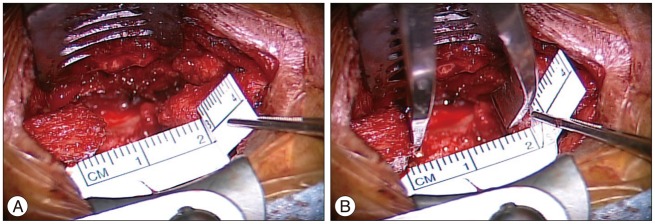
Fig. 2
Intraoperative findings during removal of the tip of the superior articular process. A : Tilting down the table toward the opposite side provides the surgical view to expose the tip of the superior articular process (arrowheads). B : Decompression from contralateral side enables removal of the tip and widening of the neural foramen without disruptions of overlying inferior articular process and facet capsule.
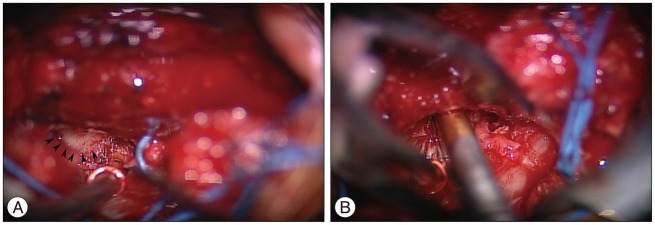
Fig. 3
Decompression of a traversing root via contralateral trajectory. Compressed root by hypertrophied articular processes (A) can be decompressed by inclined undercutting removal without disruption of facet joint and overlying capsule (B).
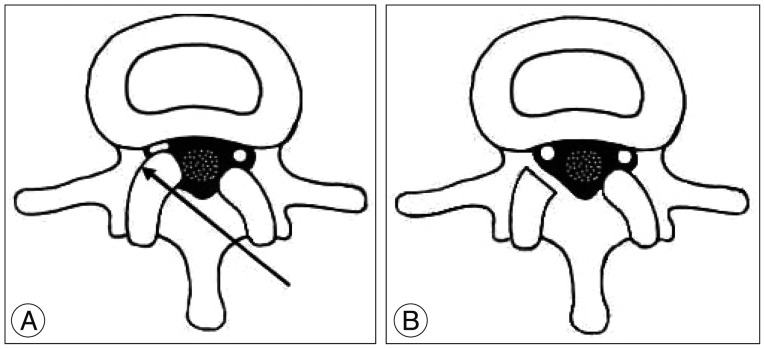
Fig. 4
Pre (A)- and post (B)-operative CT findings in a surgical patient. Angular shaped undercutting of facet joint to the pedicle is performed (left). Undercutting of the internal portion of the L4 lamina (arrowheads) is noted in coronal (middle) and sagittal (right) plane.
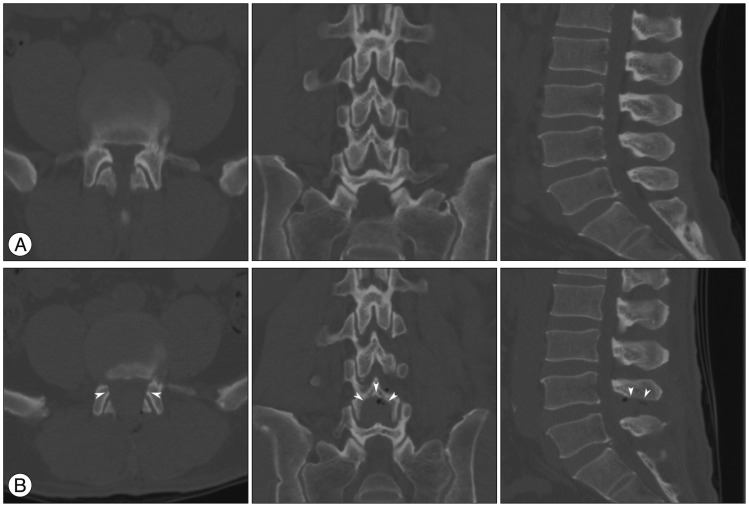
Fig. 5
Pre (A)- and post (B)-operative 3D reconstructed CT. Postoperative view (B) reveals spared portions of spinous process, lamina, and facet, compared with preoperative view (A). Postoperative view shows wide decompressed bony window including central laminoplasty area (delineated by dotted line), which decompresses proximal exiting roots and preserves facet joints.
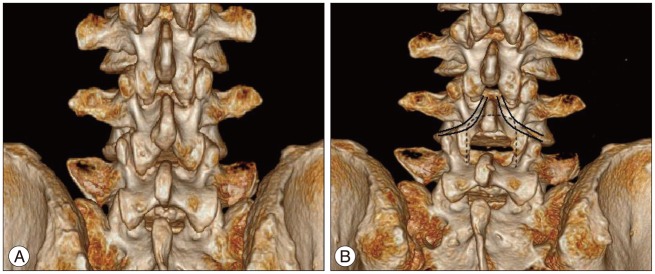




 PDF
PDF ePub
ePub Citation
Citation Print
Print


 XML Download
XML Download